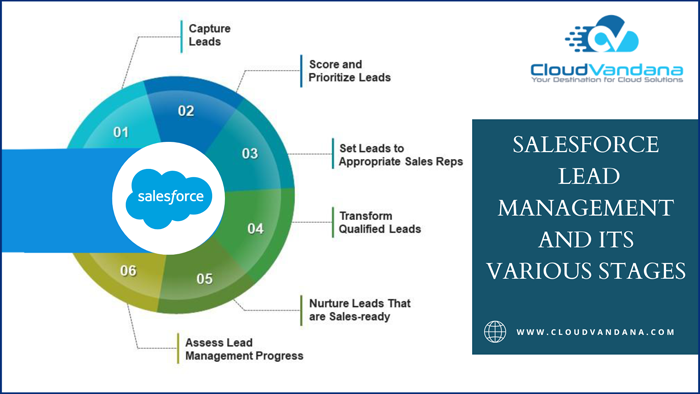Salesforce lead management is an effective system that allows users to measure the impact of marketing activities on the sales pipeline across all channels—setting up automatic lead scoring to convert more leads to opportunities and win more deals.
In this article, CloudVandana will discuss Salesforce lead management and its effective stages.
Salesforce is considered one of the most widely used CRM solutions available in the market and is popular for its customization facilities. The lead management module of Salesforce gives a comprehensive solution for end-to-end lead management processes, including lead generation, distribution, and qualification, including follow-up and conversion. So it is an excellent tool for managing leads.
The process helps businesses to convert more leads into sales to earn more revenue. The included tools help enhance the process from lead creation to lead qualification. The process helps the salespeople to concentrate on the sales process and converts the leads into finished sales transactions. Let’s look at the features of Salesforce lead management.
Lead Management Features
The platform offers various features that can help the sales team to generate and manage effective leads and convert them into sales. Features include-
1. Lead Capturing
Capturing correct leads is one of the most important tasks. This platform helps in this process by reducing manual entry by using existing information in the database, making it more convenient to capture valuable leads from websites.
2. Leads Validation
The Salesforce Lead Validation feature allows filtering out the convertible leads based on business-specific criteria assisting the sales team in focusing on good leads.
3. Leads Assigning
This Salesforce function automatically allocates to sales representatives based on industry, location, etc. The process saves time and effort for the organization by assigning leads automatically.
4. Lead Scoring
Salesforce provides a score of the leads depending on their interest in the specific product or services the organization offers. So users can focus on the valuable leads for a successful conversion.
5. Lead Nurturing
Lead nurturing helps users to send automated emails and messages to potential customers and helps them in converting leads to sales. Automated workflows help businesses to nurture leads and convert them to sales.
6. Conversion
Salesforce’s lead conversion tool allows customers to track the progress of the leads from prospect to sales conversion. In addition, it helps in determining the effectiveness of the marketing strategy.
7. Customizable Dashboards
The dashboard allows the user to access all the information about leads and their status. Users can use customizable tools to add filters to search for specific leads.
8. Lead management automation
Salesforce Lead Management Automation increases the efficiency of an organization by automating repetitive tasks so that employees can focus on other important tasks.
Stages Of Salesforce Lead Management Process
1. Attracting Prospects
A huge number of leads increase the probability of more sales. The function consists of various features that can help businesses to get more leads by automating the lead-generation process. The Salesforce data import wizard tool helps users to import massive amounts of information pertinent to leads in one go. It enables users to import data from Excel spreadsheets, Gmail, Outlook, and other similar channels.
2. Identifying Sales Conversions
Identifying and filtering useful leads is always a matter of concern for organizations. Identifying good leads prevents businesses from wasting their time and efforts on dead leads. So, there should be a standard criterion for lead qualification. Salesforce helps in the whole process of driving leads through it to convert them into sales.
3. Set Priorities
Lead conversion is a time-sensitive process. If the sales team wastes time in response or other follow-ups, there is a high chance of losing the lead. Here comes the Salesforce lead management as a savior. The function helps users to utilize the best chances so that the sales team can respond quickly. It enables users to provide timely responses to potential customers to keep the interaction smooth to increase the probability of sale conversions.

4. Convert Quality Leads Into Opportunities
The leads should be properly guided toward the path of conversion. A follow-up task can be assigned to ensure that leads do not remain leads for an extended period.
5. Nurturing
The nurturing process is one of the essential aspects of the lead generation process. The nurturing process is sometimes overlooked, but this process should be handled with great care. The process should offer a personalized and customized experience to the prospect for a higher conversion rate.
6. Asses The Lead Management
Salesforce CRM provides a centralized platform to users where they can store all the lead management data for better lead management. The team can use data analysis to find areas where the lead management process could be enhanced. This procedure should be done frequently to keep the sales funnel flowing smoothly. Users can track the progress of lead generation activities using various metrics like sales conversions and the number of leads.
Are you looking for a Salesforce Partner to implement Salesforce CRM in your organization for a seamless customer experience? Please schedule a consultation with the Salesforce experts of CloudVandana or take the Salesforce Staff Augmentation service for end-to-end support. Call us now.










